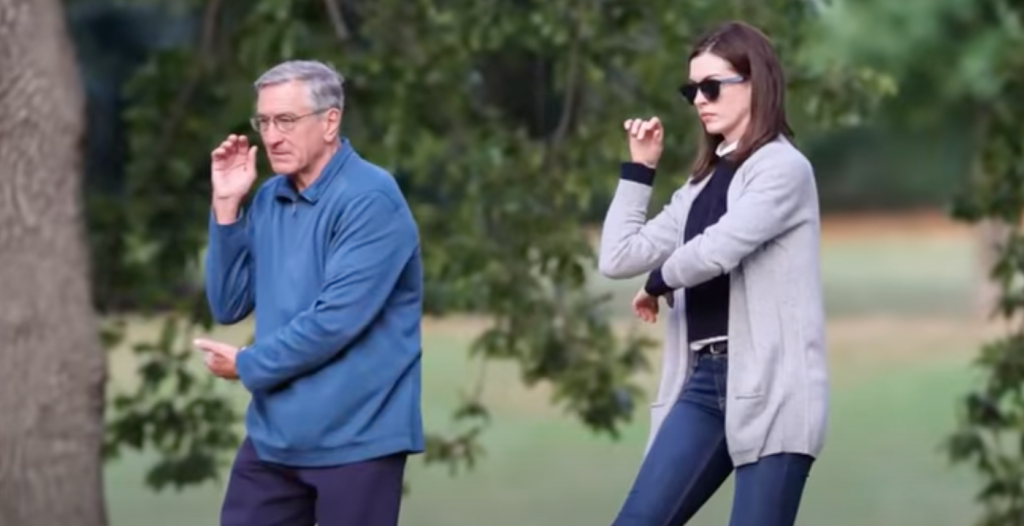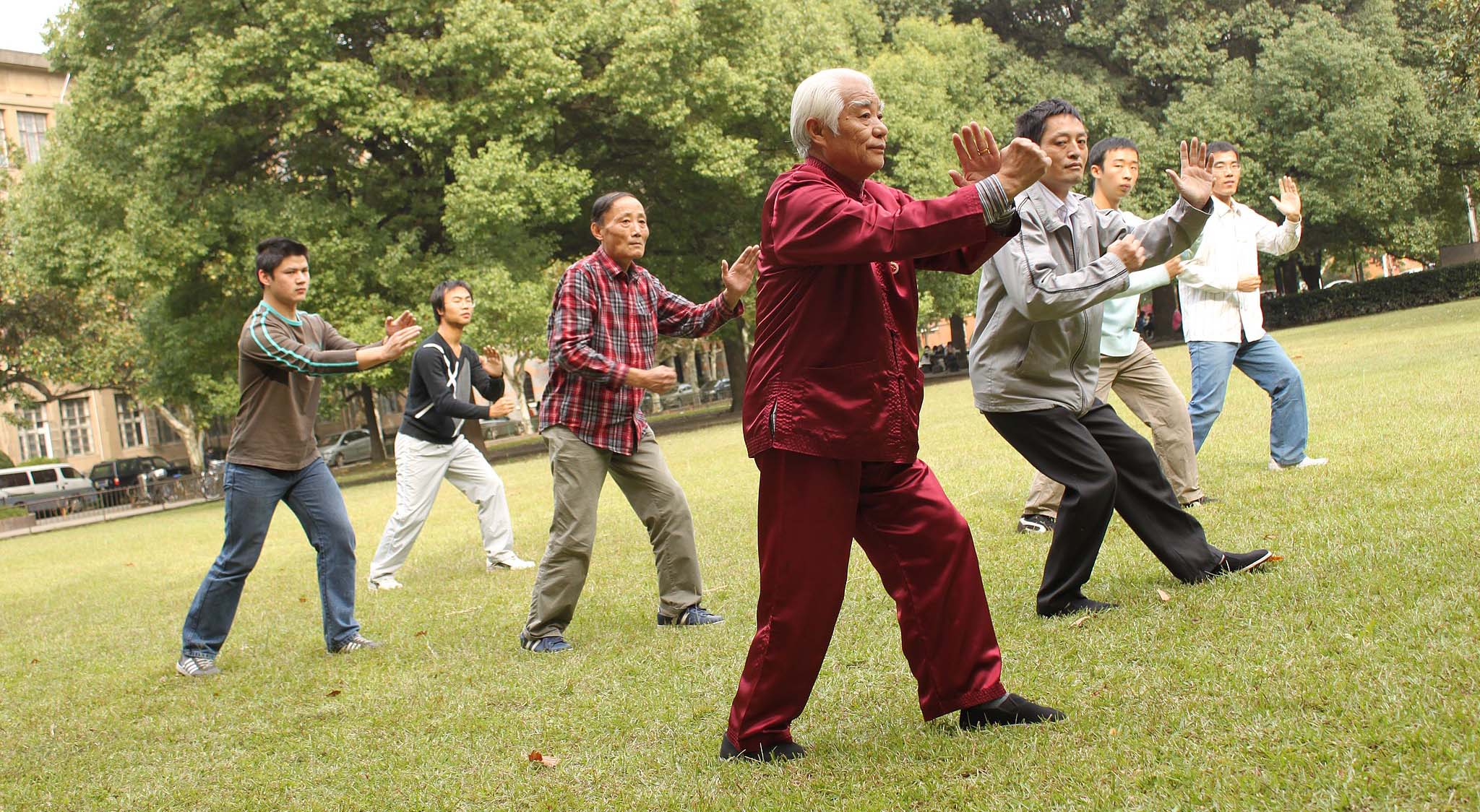THE GRACEFUL CHINESE exercise known as Tai Chi Chaun is gradually spreading around the world – and even into the fictional world of Hollywood movies. “I love the idea of having a place I can go every day. I want the connection, the excitement. I wanna be challenged,” says Robert De Niro, playing a retired executive in the hit Hollywood movie, The Intern.
De Niro’s character, Ben, is in his 70s. He gets an opportunity to work as a senior intern under Jules, a young and frenetic founder of a booming fashion e-commerce startup, played by Anne Hathaway. The comedy is based on the contrast between the high-speed futuristic life of Jules and the slow, traditional values of Ben. And in true Hollywood style (this is too obvious to be a spoiler), Ben is the underdog but ends up teaching Jules an important lesson about life – symbolized by a key scene at the end.
As the movie wraps up, Hathaway joins De Niro for his favourite Tai Chi class in Brooklyn’s Prospect Park. And the energetic, buzzing young woman finally starts to pick up some of the calmness of mind that she needs.

Many foreign celebrities have dabbled in Chinese traditions in real life, too: we have already written about their love of acupuncture. But martial arts techniques in particular not only boost well-being, but also keep people’s bodies strong and flexible, and their minds focused. Among several celebrities practising Tai Chi are Hollywood actor Mel Gibson and British supermodel Naomi Campbell.
“I really enjoyed Tai Chi,” Campbell said in an interview. “I thought it was gonna be easy, but it’s so disciplined. You’ve got to hold everything, it’s got to be slow-moving. But I loved it — mentally, I loved it.”

ANCIENT ART
Tai Chi is centuries old, although it’s hard to pin down specific dates. That’s because it started as exercises focused on martial (fighting) moves, but somewhere along the way become mixed with Daoist and Buddhist principles. Probably the original form was a type of “shadow boxing” or slow motion fighting. As people concentrated on balance and posture, it gradually lost any association with hurting enemies and evolved into an exercise for the body which was incidentally also found to have a powerful calming effect on the mind.
The modern form, with the present name, probably dates back to the mid-1800s, according to academic research. Before that it had various names, including “soft boxing”.
Today, it has lost all of its fighting aspect, and it seen as a celebration of Yin-Yang, which is all about the balance of opposites. It involves mind and body, the opening and closing of movements, increasing speed and slowing down, stillness (yin) and activity (yang).
MEDITATION IN MOTION
Tai Chi is now seen as a dynamic form of meditation in motion, bringing peace of mind without actually being physically still. In today’s hectic world, where life is fast-paced, Tai Chi helps us to slow down and rebalance ourselves while gently exercising the body.
By focusing on the slow, flowing and meditative movements along with breathing pattern, our minds become calm and stable. The exercise stresses relaxation, the cultivation of inner strength, and harmony of body and mind.
The centuries-old movements bring practitioners balance between themselves and the natural environment around them, which is why is it regarded as a form of inner martial art.

BRAIN BOOST
The practice of Tai Chi or other such exercises will also help enhance brain power. Recently academics from the University of Canberra conducted a study to investigate the links between exercises and brain health among people aged over 50.
The study found physical exercise significantly improves cognitive function in adults older than 50 years and Tai Chi is a promising intervention aimed at brain health.
Meanwhile, Tai Chi helps improve cognitive abilities. Because of Tai Chi’s low impact nature, it is accessible to people who might not be able to do more intensive exercise and so finding that it is associated with improved brain health.
STRENGTH REQUIRED
As a moderate-intensity exercise, Tai Chi is suitable for both young and older adults. The non-traditional modes of exercise may be suitable for less functional people. Tai Chi can help meet people’s exercise goals as its slow and purposeful movements require strength and coordination. Its movements are circular and never forced, and practitioners’ muscles are relaxed.
The mind-body meditative exercise advances overall balance, improves muscle strength, boosts flexibility and body coordination.
Also, Tai Chi helps energize and balance body’s vital energy, or Qi. Based on Traditional Chinese Medicine principles, when Qi is balanced, your body functions at its best. This energy is the vitality that flows through the body and gives life and direction to all matter. A balanced movement of Qi has the power to strengthen and energize the body.
The set of movements from Tai Chi are a treasure trove of exercises that are much needed in the world.
Practising Tai Chi gives people a chance to attain happiness, balance, relaxation, physical and mental health – which are the reasons that the meditative exercise is popping up everywhere, including in Hollywood movies.
Though Tai Chi looks simple and effortless, practitioners have to spend time to learn it well. When De Niro starred in The Intern, he worked hard to learn how to practice Tai Chi before filming.
If you need to balance on one leg for a minute or two, special effects and green-screen techniques aren’t going to help you, even if you are a Hollywood star.
Image at the top shows Group Tai Chi practice in a Shanghai park led by Grandmaster Xie Bingcan in 2011. Picture by Seattletaijiquan, CC BY-SA 4.0

